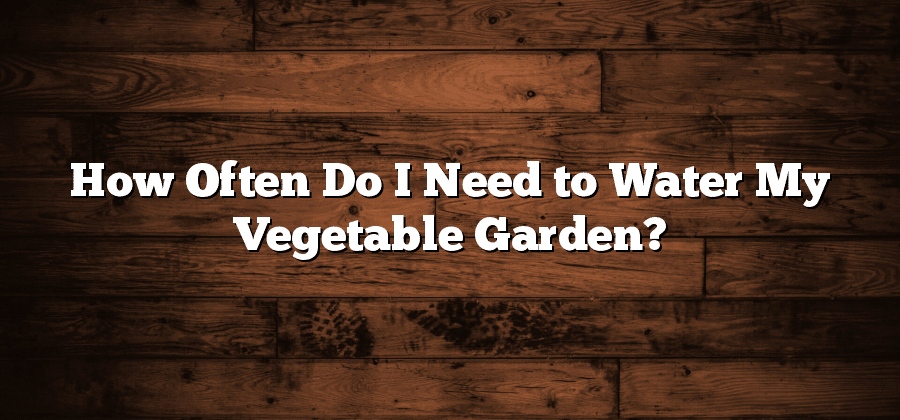Best Practices for Watering Your Vegetable Garden
Watering your vegetable garden is an essential task that requires careful attention and adherence to best practices. Proper watering not only ensures the healthy growth and development of your plants, but also helps conserve water and prevent wastage. To ensure you are watering your vegetable garden effectively, consider the following guidelines.
First and foremost, it is crucial to establish a regular watering schedule. Consistency is key to maintaining optimal soil moisture levels for your vegetables. Depending on the weather conditions and the specific needs of your plants, you may need to water every other day, every three days, or even once a week. Monitoring the weather forecast and observing the moisture levels of your soil will help you determine the frequency of watering needed. In addition, watering in the early morning or late evening is generally recommended, as this allows the water to soak into the soil without excessive evaporation due to sunlight and heat.
Factors Affecting Watering Frequency
Soil type and composition play a significant role in determining the watering frequency for your vegetable garden. Sandy soil, for example, allows water to drain quickly, leading to more frequent watering needs. On the other hand, clay soil retains water longer, requiring less frequent watering. It is important to understand the unique characteristics of your soil to properly gauge the watering needs of your vegetables.
Another factor influencing the watering frequency is the local climate and weather patterns. Hot and arid climates will inevitably result in higher watering requirements for your vegetable garden. Similarly, periods of prolonged drought will necessitate more frequent watering. It is crucial to stay informed about the weather conditions in your area and adjust the watering schedule accordingly to prevent under or overwatering your plants.
By considering the soil type, climate, and specific water requirements of each vegetable variety, you can establish an effective watering routine for your garden. Understanding these factors will not only promote the overall health and productivity of your plants but also help conserve water and ensure sustainable gardening practices.
Signs Your Vegetable Garden Needs Watering
The health and productivity of a vegetable garden relies heavily on adequate water supply. It is crucial for gardeners to be able to identify signs that their garden is in need of watering. One of the first indicators to look out for is the appearance of wilting plants. When plants do not receive enough water, they begin to droop and lose their turgidity. Leaves may also turn yellow or brown, signaling that water stress has set in. In addition to visual cues, pay attention to the texture of the soil. If the top few inches of soil feel dry to the touch, it is a clear indication that your vegetable garden is in need of a good watering.
• Wilting plants: Look out for drooping and sagging plants, as this is a clear sign of water deficiency.
• Discoloration of leaves: Yellow or brown leaves indicate that the plants are experiencing water stress and need watering.
• Dry soil: Check the texture of the top few inches of soil. If it feels dry to the touch, it’s time to water your vegetable garden.
• Cracked soil surface: When the soil becomes extremely dry, it may crack on the surface. This is another indication that watering is needed.
• Reduced growth rate: If you notice a significant slowdown in plant growth or smaller than usual harvests, insufficient watering could be to blame.
• Increased pest activity: Lack of moisture can weaken plants and make them more susceptible to pests such as aphids and spider mites. An increase in pest activity could mean your garden needs watering.
By paying attention to these signs, gardeners can ensure their vegetable gardens receive adequate hydration. Regularly monitoring plant health and adjusting irrigation practices accordingly will help maintain a thriving and productive garden throughout the growing season.
Understanding Soil Moisture Levels
One key aspect of successful vegetable gardening is understanding soil moisture levels. Proper moisture is essential for plant growth and health. To determine the moisture levels in your soil, you can use a simple technique called the finger test.
To perform the finger test, insert your index finger into the soil near the plant’s root zone. If the soil feels dry to the touch, it is an indication that the plants may need watering. On the other hand, if the soil feels moist, it is likely that the plants have sufficient water. Remember to perform the test in multiple areas of the garden to get an accurate representation of the moisture levels across your garden.
Determining the Water Needs of Different Vegetables
The water needs of different vegetables can vary greatly, depending on various factors such as the plant species, weather conditions, and the stage of growth. It is essential to understand these factors in order to determine the proper watering requirements for your vegetable garden.
One factor to consider is the type of vegetable you are growing. Leafy greens like lettuce and spinach typically require more frequent watering to maintain their crispness and prevent wilting. On the other hand, root vegetables such as carrots and radishes have deeper root systems that allow them to access water from deeper in the soil, so they generally require less frequent watering.
Another crucial factor is the weather conditions. During hot and dry periods, vegetables tend to lose more water through evaporation and transpiration. This means that they will require more frequent watering to replenish the lost moisture and prevent dehydration. On the contrary, during cooler and rainy seasons, the water needs of vegetables may decrease as natural rainfall can provide sufficient moisture for their growth.






